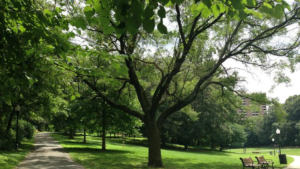Maryland’s Forests and a Law Designed to Protect? Here’s What I Think.
THE BALTIMORE SUN
Time to close the loopholes on Md.’s forest conservation law
 Just across from the Baltimore Museum of Art is a stairwell that leads down into a secluded park. Although it’s surrounded by bustling city traffic, the brick walls and tall trees keep the park hidden. Talk about urban picnicking. (Alexa Cottman-Robinson)
Just across from the Baltimore Museum of Art is a stairwell that leads down into a secluded park. Although it’s surrounded by bustling city traffic, the brick walls and tall trees keep the park hidden. Talk about urban picnicking. (Alexa Cottman-Robinson)
Dick Williams, Bernadette Roche
FEBRUARY 21, 2019 11 AM
Trees are a natural bulwark against the dangers of global warming, especially when they are grouped in continuous stands called forests. They knock down airborne particulate matter and sequester carbon and nitrogen dioxide — menacing greenhouse gases from tailpipes, smokestacks and buildings. They also are nature’s defense against the “heat island effect” stemming from way too much hardscape (roads, parking lots, roofs) in our cities and suburbs that over-heat our atmosphere, particularly during sunny summer days.
Forests in urban areas are particularly effective as nature’s green infrastructure answer to stormwater management and the need for clean water for marine life. As with rural forestland, urban forests — such as Druid Hill Park in Baltimore — continue to serve as wildlife habitat, assuring a place for nature’s course in addition to humankind’s.
In 1991, the Maryland legislature passed the Forest Conservation Act (FCA) aimed at restoring forests to counteract the effect of larger-scale tree and forest demolition for housing developments and commercial or industrial projects. The FCA currently requires that for every four acres of forest removed, only one acre of trees must be planted in nearby areas or, regionally, as mitigation or reforestation.
Trouble is, the FCA left loopholes or didn’t anticipate the several accountability initiatives necessary for positive forest outcomes. As a result, thousands or more of our best acres (“Priority Forest Areas”) have been cleared, while many hundreds of replacement acres of trees remain unplanted. Since 1991 the net loss of forest land in our state has hit a staggering level of 100,000 acres. And more forest loss is projected by Chesapeake Bay Program models, thus further exposing Marylanders to the human- and wildlife-harming repercussions of global warming.
A suite of three bills to tighten up the intents of the FCA is now before the 2019 legislative session of the Maryland General Assembly. They are: “No Net Loss of Forest” (House Bill 120/Senate Bill 203); “State and Local Forest Conservation Funds” (H.B. 272/S.B. 234); and the “Forest Conservation Task Force” (H.B. 735/S.B. 729).
The “No Net Loss of Forest” legislation would clarify that forests should be maintained at current statewide levels. Forests are a biological community characterized by trees and other woody plants comprising a minimum of 10,000 square feet. The current definition of our state goal refers to “tree canopy,” which, in effect, allows forested acreage to be cut down and replaced by subdivisions with street trees — the “tree canopy.” But forests provide ecological functions that are not obtained with rows of subdivision trees that presently qualify toward tree canopy coverage. This bill would correct the state goal so that future policy decisions are aimed at protecting forests.
The “State and Local Forest Conservation Funds” legislation aims to remedy the historical lack of replacement trees planted to offset forest loss. Presently, local governments are authorized to create fee-in-lieu programs; in other words, prior to obtaining a building permit, developers pay into such programs the total cost of replanting the trees that would be lost in the proposed development. Thus developers are relieved of the responsibility for mitigation work.
The problem is, local governments don’t presently have a legal obligation to act in the developers’ (and their citizens’) interests to fully mitigate or reforest with funds paid. Many local governments are sitting on the cash instead of investing in reforestation. This legislation, if passed, would obligate local governments to execute reforestation according to the intent of the original law by setting up mitigation or reforestation plans and starting the catch-up work.
The “Maryland Forest Conservation Action Task Force,” the final of the three improvements, addresses climate resilience by calling for the nomination of a diverse group of stakeholders to quantify and address future forest outcomes. One issue is deforestation by utility line construction and electricity generation facilities, currently exempted from the FCA. Employing land use plans and tools such as the Chesapeake Bay Program Phase 6 Model, stakeholders would work toward outcomes that stem deforestation while addressing future maintenance costs for healthy forests. Climate resilience is strategic and tactical in absorbing climate stresses while maintaining sustainable social and positive economic function.
We call on our fellow Marylanders to contact your legislators immediately, urging them to pass this suite of bills to improve our current systems and to find a path to overcome forestation loss since 1991 and as projected into the future.
Dick Williams is a certified Baltimore TreeKeeper, and Bernadette Roche is director of environmental and Sustainability Studies at Loyola University Maryland. Together, they are co-leads of Maryland Episcopal Environmental Partners.